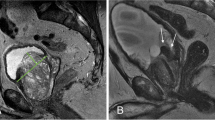Abstract
Objectives
To evaluate the short- and medium-term results of prostatic arterial embolisation (PAE) for benign prostatic hyperplasia (BPH).
Methods
This was a prospective non-randomised study including 255 patients diagnosed with BPH and moderate to severe lower urinary tract symptoms after failure of medical treatment for at least 6 months. The patients underwent PAE between March 2009 and April 2012. Technical success is when selective prostatic arterial embolisation is completed in at least one pelvic side. Clinical success was defined as improving symptoms and quality of life. Evaluation was performed before PAE and at 1, 3, 6 and every 6 months thereafter with the International Prostate Symptom Score (IPSS), quality of life (QoL), International Index of Erectile Function (IIEF), uroflowmetry, prostatic specific antigen (PSA) and volume. Non-spherical polyvinyl alcohol particles were used.
Results
PAE was technically successful in 250 patients (97.9 %). Mean follow-up, in 238 patients, was 10 months (range 1–36). Cumulative rates of clinical success were 81.9 %, 80.7 %, 77.9 %, 75.2 %, 72.0 %, 72.0 %, 72.0 % and 72.0 % at 1, 3, 6, 12, 18, 24, 30 and 36 months, respectively. There was one major complication.
Conclusions
PAE is a procedure with good results for BPH patients with moderate to severe LUTS after failure of medical therapy.
Key Points
• Prostatic artery embolisation offers minimally invasive therapy for benign prostatic hyperplasia.
• Prostatic artery embolisation is a challenging procedure because of vascular anatomical variations.
• PAE is a promising new technique that has shown good results.









Similar content being viewed by others
Abbreviations
- BPH:
-
benign prostatic hyperplasia
- PAE:
-
prostatic artery embolisation
References
Levy A, Samraj GP (2007) Benign prostatic hyperplasia: when to ‘watch and wait’, when and how to treat. Cleve Clin J Med 74:S15–S20
Garraway WM, Collins GN, Lee RJ (1991) High prevalence of benign prostatic hypertrophy in the community. Lancet 338:469–471
Michel MC, Mehlburger L, Bressel HU, Schumacher H, Schäfers RF, Goepel M (1998) Tamsulosin treatment of 19,365 patients with lower urinary tract symptoms: does co-morbidity alter tolerability? J Urol 160:784–791
McConnell JD, Bruskewitz R, Walsh P et al (1998) The effect of finasteride on the risk of acute urinary retention and the need for surgical treatment among men with benign prostatic hyperplasia. Finasteride Long-Term Efficacy and Safety Study Group. N Engl J Med 338:557–563
Varkarakis J, Bartsch G, Horninger W (2004) Long-term morbidity and mortality of transurethral prostatectomy: a 10-year follow-up. Prostate 58:248–251
Roehrborn CG, Rosen RC (2008) Medical therapy options for aging men with benign prostatic hyperplasia: focus on alfuzosin 10 mg once daily. Clin Interv Aging 3:511–524
Burnett AL, Wein AJ (2006) Benign prostatic hyperplasia in primary care: what you need to know. J Urol 175:S19–S24
Baazeem A, Elhilali MM (2008) Surgical management of benign prostatic hyperplasia: current evidence. Nat Clin Pract Urol 5:540–549
Reich O, Gratzke C, Bachman A et al (2008) Morbidity, mortality and early outcome of transurethral resection of the prostate: a prospective multicenter evaluation of 10,654 patients. J Urol 180:246–249
Madersbacher S, Marberger M (1999) Is transurethral resection of the prostate still justified? BJU Int 83:227–237
DeMeritt JS, Elmasri FF, Esposito MP, Rosenberg GS (2000) Relief of benign prostatic hyperplasia-related bladder outlet obstruction after transarterial polyvinyl alcohol prostate embolization. J Vasc Interv Radiol 11:767–770
Carnevale FC, Antunes AA, da Motta Leal Filho JM et al (2010) Prostatic artery embolization as a primary treatment for benign prostatic hyperplasia: preliminary results in two patients. Cardiovasc Intervent Radiol 33:355–361
Pisco JM, Pinheiro LC, Bilhim T, Duarte M, Mendes JR, Oliveira AG (2011) Prostatic arterial embolization to treat benign prostatic hyperplasia. J Vasc Interv Radiol 22:11–19
Sun F, Sánchez FM, Crisóstomo V et al (2008) Benign prostatic hyperplasia: transcatheter arterial embolization as potential treatment—preliminary study in pigs. Radiology 246:783–789
Jeon GS, Won JH, Lee BM et al (2009) The effect of transarterial prostate embolization in hormone-induced benign prostatic hyperplasia in dogs: a pilot study. J Vasc Interv Radiol 20:384–390
Mauro MA (2008) Can hyperplastic prostate follow uterine fibroids and be managed with transcatheter arterial embolization? Radiology 246:657–658
Bilhim T, Casal D, Furtado A, Pais D, O’Neill JE, Pisco JM (2011) Branching patterns of the male internal iliac artery: imaging findings. Surg Radiol Anat 33:151–159
Bilhim T, Pisco JM, Furtado A et al (2011) Prostatic arterial supply: demonstration by multirow detector angio CT and catheter angiography. Eur Radiol 21:1119–1126
Sapoval M, Daroles J, Rio Tinto H et al (2012) C-arm cone-beam CT in BPH: techniques and considerations for the safe treatment of benign prostatic hyperplasia. Endovascular Today April:61–63
Conflict of interest
There is no funding or potential conflicts of interest for the authors regarding this article. The corresponding authors confirm that they have full access to all the data in this study and have final responsibility for the decision to submit for publication. All authors had full access to all of the data in the study and take responsibility for the integrity of the data and the accuracy of the data analysis.
Author information
Authors and Affiliations
Corresponding author
Rights and permissions
About this article
Cite this article
Pisco, J.M., Rio Tinto, H., Campos Pinheiro, L. et al. Embolisation of prostatic arteries as treatment of moderate to severe lower urinary symptoms (LUTS) secondary to benign hyperplasia: results of short- and mid-term follow-up. Eur Radiol 23, 2561–2572 (2013). https://doi.org/10.1007/s00330-012-2714-9
Received:
Revised:
Accepted:
Published:
Issue Date:
DOI: https://doi.org/10.1007/s00330-012-2714-9




